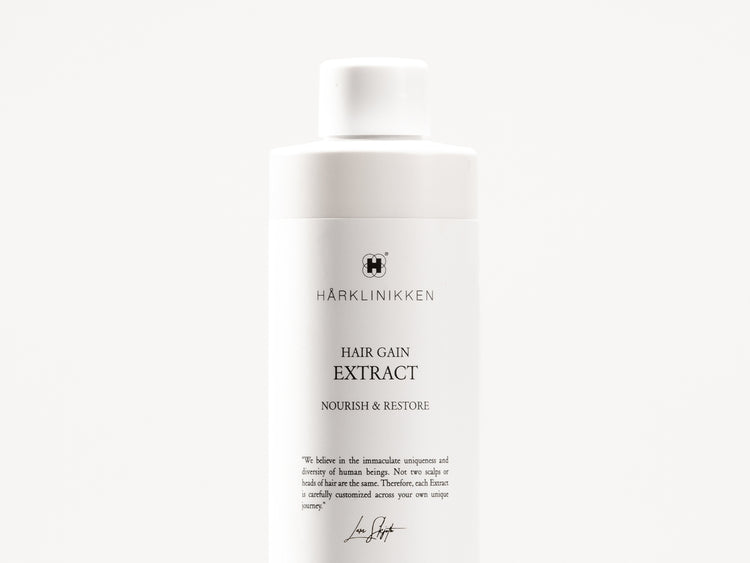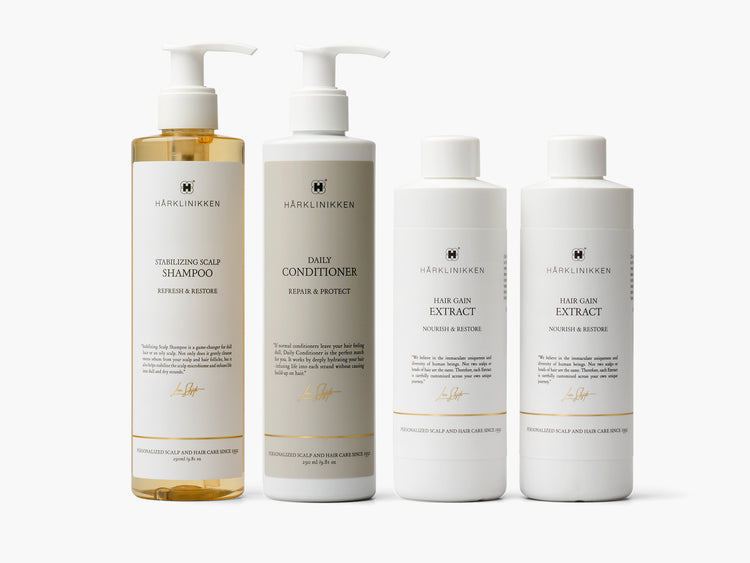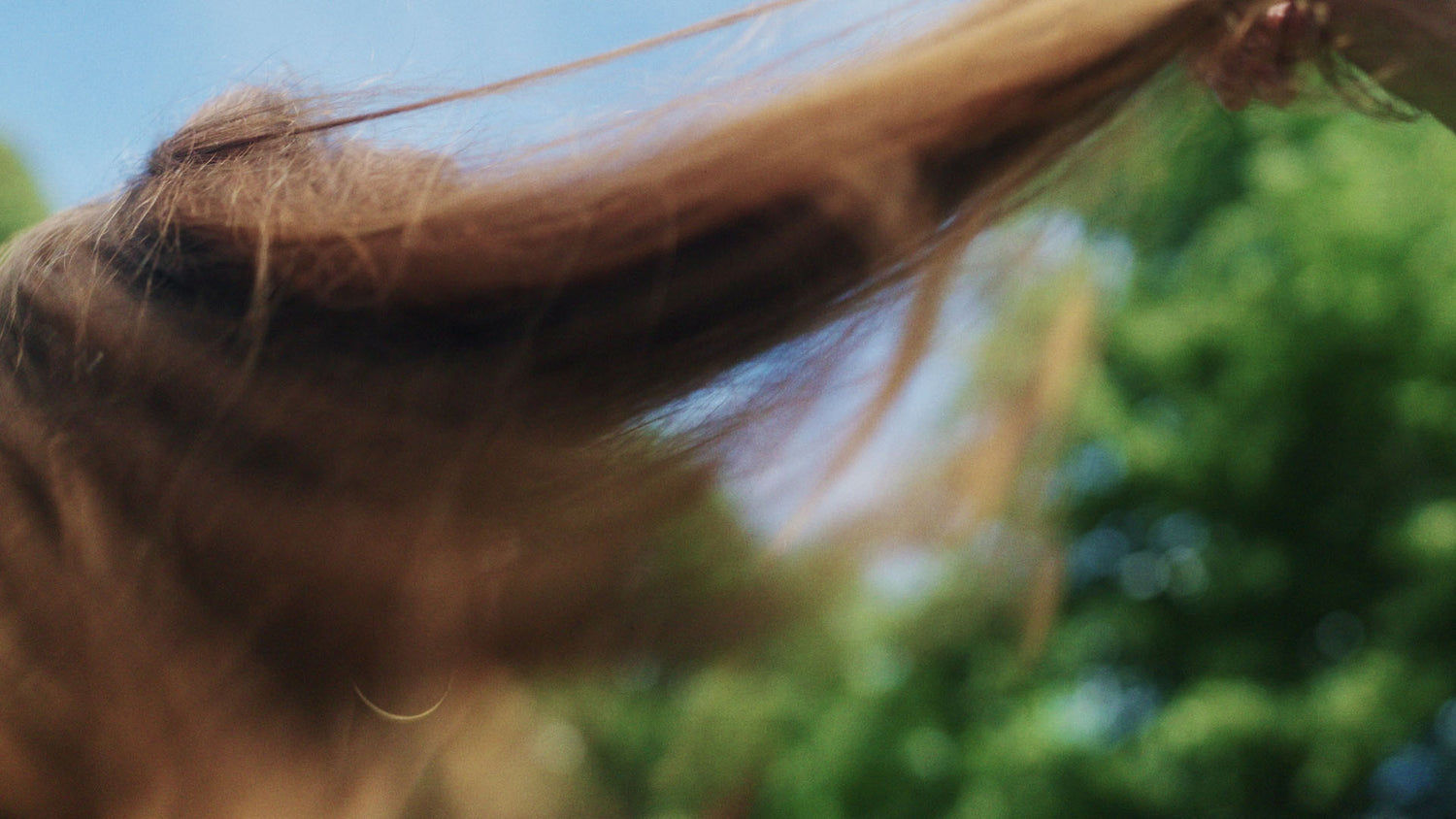The hair growth cycle is made up of three phases, each one vital to the overall process. But like many of the body’s regenerative processes, it’s affected by hormones, genetics, stress, ageing and more. It’s important to understand what a healthy version of the hair growth cycle is to identify issues that may arise, potentially signalling hair loss or thinning.
Anatomy of a hair follicle
A tube-like pore, the hair follicle is where hair grows. The follicle is attached to a sebaceous gland, an arrector pili muscle, and tiny blood vessels known as capillaries. At the base of the follicle is the bulb, which contains growing hair cells. No new hair follicles are created after birth, so it’s important to have them functioning at their best. For optimal function, a hair follicle needs rich blood flow (to receive all the nutrients and oxygen it requires) and to be clear of buildup.
Anatomy of a hair strand
A strand of hair is made up of three key parts: the medulla (the innermost layer), the cortex (the middle layer) and the cuticle (the outer layer). The cortex and cuticle are present in all hair types, but some finer hair types may not have a medulla.
What are the phases of the hair growth cycle?
The three stages of the hair growth cycle are anagen (growth), catagen (transition) and telogen (resting) phases. Each of these phases lasts for a different amount of time, but it’s typically the telogen phase that people notice the most – as that is when the hair sheds.
Anagen (Growth) Phase
During the anagen phase, the hair follicle is actively producing hair cells.
Duration: about three to seven years, sometimes longer
Catagen (Transition) Phase
Throughout the catagen phase, hair follicles regress and detach from the dermal papilla in the hair follicle – but remain in place.
Duration: about one to two weeks
Telogen (Resting) Phase
This stage is when new hairs begin forming in the follicles that are shedding old strands. When more than 10 % of your hair follicles enter the telogen phase at the same time, it can lead to a condition called telogen effluvium, which appears as excessive hair shedding.
Duration: about three to four months
How fast should hair grow?
This varies from person to person, especially if they are experiencing miniaturisation. On average a strand of hair grows about .2in to .7in (about .5cm to 1.8cm) each month, however the average is closer to .4in or 1cm. The hair miniaturisation process results in hair becoming thinner, finer and more fragile, causing your hair to grow slower and slower over time. Noticing your hair doesn’t grow as long as it used to can be a signal of miniaturisation, not only as the growth has slowed but also because the hair is weaker and breaks before reaching longer lengths.
How much hair is normal to shed every day?
It’s normal to lose around 50 to 100 hairs a day, but who’s counting? If you're experiencing excessive shedding (noticing much more hair in your brush or shower drain) it could be a short-term condition of telogen effluvium or it could be the miniaturisation process.
What factors disrupt the hair growth cycle?
There are many internal and external elements that impact the hair growth cycle. These are the main ones:
- Hormonal Changes
A crucial element in regulating the hair growth cycle, hormones play a key role in your scalp and hair health and function. Imbalances in hormones – caused by everything from stress, ageing to pregnancy, PCOS, perimenopause, menopause and thyroid issues can lead to hair thinning or loss.
- Ageing
Typically, the rate of hair growth slows down as we age, and hair follicles may produce thinner, weaker hair.
- Nutritional Deficiencies
The scalp, hair follicles and hair require various nutrients to grow healthily. Deficiencies in nutrients (vitamins, minerals, amino acids, and fatty acids) can impair hair growth and lead to shedding or thinning. A well-balanced diet made up of mainly unprocessed, nutrient-dense food supports the hair growth cycle, scalp health and overall wellbeing.
- Stress
An unavoidable part of life, stress can affect your scalp and hair, as well as your overall health. High levels of stress can trigger telogen effluvium – a condition where a large number of hair follicles enter the resting phase prematurely, leading to increased hair shedding. Chronic stress can also affect hormonal balance.
- Poor Scalp Health
For optimal function, the scalp and hair follicles need to be clear of buildup from sebum, dead skin cells, product, dirt and more. Conditions like dandruff, psoriasis and fungal infections can also have negative effects, so it’s important to take steps to create optimal scalp health.
Identifying the difference between breakage and new growth
It’s often difficult to tell the difference between new growth and breakage, especially because they can look the same to the naked eye. However, a common sign of breakage is frayed ends – short, frayed, or split ends– which can be more noticeable when you comb or brush your hair. New growth, on the other hand, can sometimes be identified with consistency of hair length – if your hair is consistently growing and becoming longer over time. A few months after improving your scalp health, it’s common to see a lot of hair coming in at the same length. New hair strands are pointy (like a sewing needle) as they haven’t been trimmed yet and aren’t broken.
FAQs
What is baby hair?
A term used to describe fine, wispy strands of hair (often noticeable at your temples and the nape of your neck), “baby hair” can signal new growth, but can also be a sign of hair miniaturisation.
Should I exfoliate my scalp to promote new hair growth?
We don’t recommend using anything on your scalp other than our meticulously formulated shampoos and your fingertips. Exfoliating products, scalp massagers and even your fingernails can be too rough on the delicate scalp skin, possibly causing damage to your follicles.
Will supplements help my hair grow?
In theory, supplements should provide you with an extra dose of the vitamins, minerals and other nutrients needed for increased hair growth. In practice, many supplements won’t deliver on that promise because they contain unnecessary or substandard ingredients. Some supplements on the market also contain absurd amounts of specific constituents like biotin – this can potentially lead to negative results and have serious implications.
Will Hårklinikken’s Hair Supplement help my hair grow?
Our Hair Supplement* is part of the entire Hårklinikken approach to growing stronger, healthier hair and has been designed to target eight functional areas that are key contributors to hair loss. The Harklinikken Hair Supplement addresses three biological triggers (including stress, DHT sensitivity and nutrient deficiencies) while also supporting five factors essential to hair growth, health, strength and density. The supplement has been designed to be a complimentary product to our award-winning Hair Gain Extract.
*Hårklinikken has decided to launch the Hair Supplement in the US first, with hopes to extend its availability to other markets in the future.

Unsure where to start?
Taking proper care of your hair and scalp health requires a comprehensive, personalised approach involves a holistic approach. If you’re ready to try the Hårklinikken way, book a consultation or take our virtual Hair Assessment.





